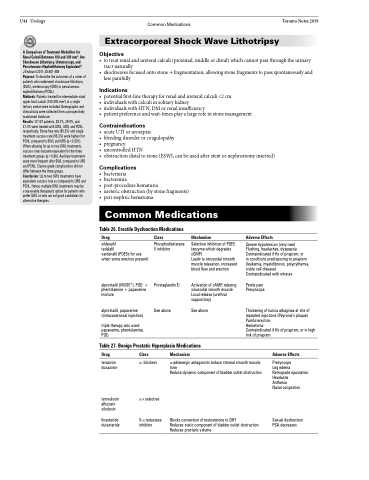Page 1362 - TNFlipTest
P. 1362
U44 Urology
A Comparison of Treatment Modalities for Renal Calculi Between 100 and 300 mm2: Are Shockwave Lithotripsy, Ureteroscopy, and Percutaneous Nephrolithotomy Equivalent?
J Endourol 2011;25:481-485
Purpose: To describe the outcomes of a series of patients who underwent shockwave lithotripsy (SWL), ureteroscopy (URS) or percutaneous nephrolithotomy (PCNL). Methods:Patientstreatedforintermediate-sized upper tract calculi (100-300 mm2) at a single tertiary centre were included. Demographic and clinical data were collected from a prospectively maintained database.
Results: Of 137 patients, 38.7%, 29.9%, and 31.4% were treated with SWL, URS, and PCNL, respectively. Stone-free rate (95.3%) and single treatment success rate (95.3%) were highest for PCNL compared to SWL and URS (p<0.001). When allowing for up to two SWL treatments, success rates became equivalent for the three treatmentgroups(p=0.66).Auxiliarytreatments were more frequent after SWL compared to URS and PCNL. Clavien grade complications did not differ between the three groups.
Conclusion: Up to two SWL treatments have equivalent success rate as compared to URS and PCNL.Hence,multipleSWLtreatmentsmaybe a reasonable therapeutic option for patients who prefer SWL or who are not good candidates for alternative therapies.
Common Medications Toronto Notes 2019 Extracorporeal Shock Wave Lithotripsy
Objective
• totreatrenalandureteralcalculi(proximal,middleordistal)whichcannotpassthroughtheurinary tract naturally
• shockwavesfocusedontostone→fragmentation,allowingstonefragmentstopassspontaneouslyand less painfully
Indications
• potentialfirst-linetherapyforrenalandureteralcalculi<2cm
• individualswithcalculiinsolitarykidney
• individualswithHTN,DMorrenalinsufficiency
• patientpreferenceandwait-timesplayalargeroleinstonemanagement
Contraindications
• acuteUTIorurosepsis
• bleedingdisorderorcoagulopathy
• pregnancy
• uncontrolledHTN
• obstructiondistaltostone(ESWLcanbeusedafterstentornephrostomyinserted)
Complications
• bacteriuria
• bacteremia
• post-procedurehematuria
• uretericobstruction(bystonefragments) • peri-nephrichematoma
Common Medications
Table 26. Erectile Dysfunction Medications
Drug
sildenafil
tadalafil
vardenafil (PDE5s for use when some erection present)
alprostadil (MUSE®), PGE1 + phentolamine + papaverine mixture
alprostadil, papaverine (intracavernosal injection)
triple therapy also used: papaverine, phentolamine, PGE1
Class
Phosphodiesterase 5 inhibitor
Prostaglandin E1
See above
Mechanism
Selective inhibition of PDE5 (enzyme which degrades cGMP)
Leads to sinusoidal smooth muscle relaxation, increased blood flow and erection
Activation of cAMP, relaxing sinusoidal smooth muscle Local release (urethral suppository)
See above
Adverse Effects
Severe hypotension (very rare) Flushing, headaches, dyspepsia Contraindicated if Hx of priapism, or
in conditions predisposing to priapism (leukemia, myelofibrosis, polycythemia, sickle cell disease)
Contraindicated with nitrates
Penile pain Presyncope
Thickening of tunica albuginea at site of repeated injections (Peyronie’s plaque) Painful erection
Hematoma
Contraindicated if Hx of priapism, or in high risk of priapism
Table 27. Benign Prostatic Hyperplasia Medications
Drug
terazosin doxazosin
tamsulosin alfuzosin silodosin
finasteride dutasteride
Class
α1 blockers
α1A selective 5-α reductase
inhibitor
Mechanism
α-adrenergic antagonists reduce stromal smooth muscle tone
Reduce dynamic component of bladder outlet obstruction
Blocks conversion of testosterone to DHT
Reduces static component of bladder outlet obstruction Reduces prostatic volume
Adverse Effects
Presyncope
Leg edema Retrograde ejaculation Headache
Asthenia
Nasal congestion
Sexual dysfunction PSA decreases


